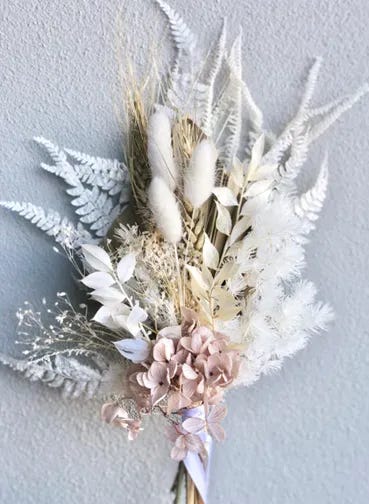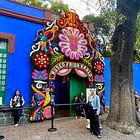That’s Sooo Pretty!: But Can I Eat it?
A Quick Guide to Edible and Poisonous Flowers and Leaves
If you’ve ever admired a delicate flower perched atop of your dessert, leaves draped over a cake, petals sprinkled on the top of your salad, or blooms suspended in ice cubes and wondered, “Can I eat that?”—you’re not alone.

Flowers and leaves have been part of culinary traditions for centuries as pretty garnishes, adding colour, fragrance, texture, interest and subtle flavours to dishes. But not all blooms and leaves are safe to eat. Here’s a quick guide to help you separate the edible from the toxic.
This post is a precursor to next week’s Flowerlogue where I show you several different ways of safely decorating a cake with flowers, rather than just plopping them on top. It’s always concerned me to see shop cakes or cakes made by family and friends with any ol’ flowers simply pushed into a beautifully iced cake, without any consideration.
Trends come and go and most recently, Erin Bunting, the coauthor of The Edible Flower, says that.
“I feel since the lockdowns of the last couple of years people are more eager to connect with nature, plants, and gardening. And that passion and interest has translated into cake decorating.”
So with that, we need to be conscious of what we are garnishing our food with.

Edible Flowers: Pretty and Harmless
1. Alyssum
2. Arugula Flowers
3. Bachelors Buttons
4. Borage (starflower)
5. Broccoli flowers
6. Calendula petals
7. Cauliflower buds
8. Chamomile
9. Chive blossoms
10. Chive flowers or buds
11. Chrysanthemum petals
12. Cilantro flowers
13. Clover
14. Cornflowers
15. Coriander
16. Courgette flowers
17. Dill
18. Elderflower
19. Fennel
20. Hibiscus
21. Lavender
Lemon Myrtle (late addition)
23. Lilac
24. Linaria
25. Lovage
26. Marigold petals
27. Marjoram
28. Mint flowers
29. Nasturtiums
30. Pansies & violas
31. Primrose
32. Rose petals
33. Rosemary
34. Sage
35. Snapdragons
36. Sunflower petals
37. Thyme flowers
38. Tuberous begonia flower petals
39. Violets
40. Zucchini blossoms

Through my research, I discovered that some flowers, like certain species of geraniums, are edible, while others are not. In the case of flowers like the wax flower, I haven’t found enough evidence to confidently say that they are safe to eat, although their tiny leaves are edible. For safety reasons, I have excluded them from the list of edible flowers. As the saying goes, "If in doubt, leave it out."
Additionally, while some flowers are non-toxic and can be used to decorate dishes, that doesn’t necessarily mean the entire flower is edible. I’d therefore recommend removing parts like the stamens, stems, anthers, and pistils, using only the petals for culinary purposes.
Poisonous Flowers: Pretty but Perilous
The following flowers may look delightful, but are highly toxic, capable of causing vomiting, diarrhea, respiratory and cardiac failure. So, in short, avoid completely.

1. Bluebells
2. Clematis
3. Daffodils
4. Delphiniums
5. Foxglove
6. Gypsophilia (Babies breath)
7. Hydrangeas
8. Lily of the Valley
9. Monkshood (Aconite)
10. Oleander
11. Poppies
12. Ranunculas
13. Rhododendron
14. Tomato flowers
15. Potato flowers
16. Wisteria
And Preserved Flowers – While these trendy decorations add a boho touch with their soft pastel hues, they are often treated with bleach, dyes, paint, and preservatives to extend their lifespan. If you choose to use them, be sure they don’t come into direct contact with food.
And it’s not just flowers that we’re all garnishing our food with. Who doesn’t love a cheese platter with olive leaves or grapevine leaves placed around.
Edible Leaves: Nature’s Greens
1. Borage (starflower)
2. Clover
3. Mountain pepper (Tasmannia lanceolata)
4. Olive
5. River mint leaves (Mentha australis)
6. Wax flower leaves (in small quantities)
7. Grapevine leaves
8. Any other edible herb, mint, bay, tarragon etc.
However, whilst leaves may be edible, they may detract from the taste, have an unpleasant texture or be very fibrous. As such best to remove it upon serving.

Flowers and leaves undoubtedly add colour, flavour texture, freshness and prettiness to our food. Today, with an ever-growing move towards healthier and organic foods, we need to make sure that they are safe.
A Few Tips
Know before you nibble. If you’re unsure about a flower’s edibility, don’t eat it.
Avoid flowers treated with poisons. Many ornamental flowers are sprayed with chemicals and fungicides that aren’t safe for consumption. Don’t forage from the roadside or use flowers from nurseries or florists as they are likely to have been treated with toxins.
Start small. Even edible flowers can cause allergies or a stomach upset, so introduce them to your diet gradually.
Grow your own edible garnishes. That way you’ll know for sure that they haven’t been sprayed with anything harmful.
Buy from organic farms, or companies that specialise in edible flowers.
Wash and drain. Clean away any dust, soil or insect dirt.
Flowers can be a delightful addition to your meals, but knowledge is key. Stick to the safe varieties and you’ll be able to enjoy the best of what nature has to offer.
I’d love to add more flowers and leaves to my list, so please let me know! Oh and share with me some of your photos of your favourite flower and leaf garnishes.
Stay tuned for my post on how to decorate cakes with flowers safely.
References:
I don’t see a lot of referencing in posts, but when it comes to health, I like to rely on the knowledge of the knowledgeable.
https://www.highspeedtraining.co.uk/hub/list-of-edible-flowers-for-cakes/
https://www.epicurious.com/expert-advice/welcome-to-the-age-of-carefree-foraged-floral-cakes
https://www.countryliving.com/food-drinks/g40277800/edible-flowers/
https://becs-table.com.au/edible-flowers/
https://roottonourish.com/2024/03/27/geraldton-waxflower-chamelaucium-uncinatum/
https://www.australiangeographic.com.au/topics/science-environment/2017/08/edible-australian-flora/











This was so interesting to read and learn. And that purple cocktail photo looks pristine...and delicious.
Having worked in fine dining for many years, I've seen plenty if dishes and cocktails garnished with lots of flower varieties. I never once took into consideration that toxicity could be a thing!
The things you learn by reading Flowerlogues, hey? 😉